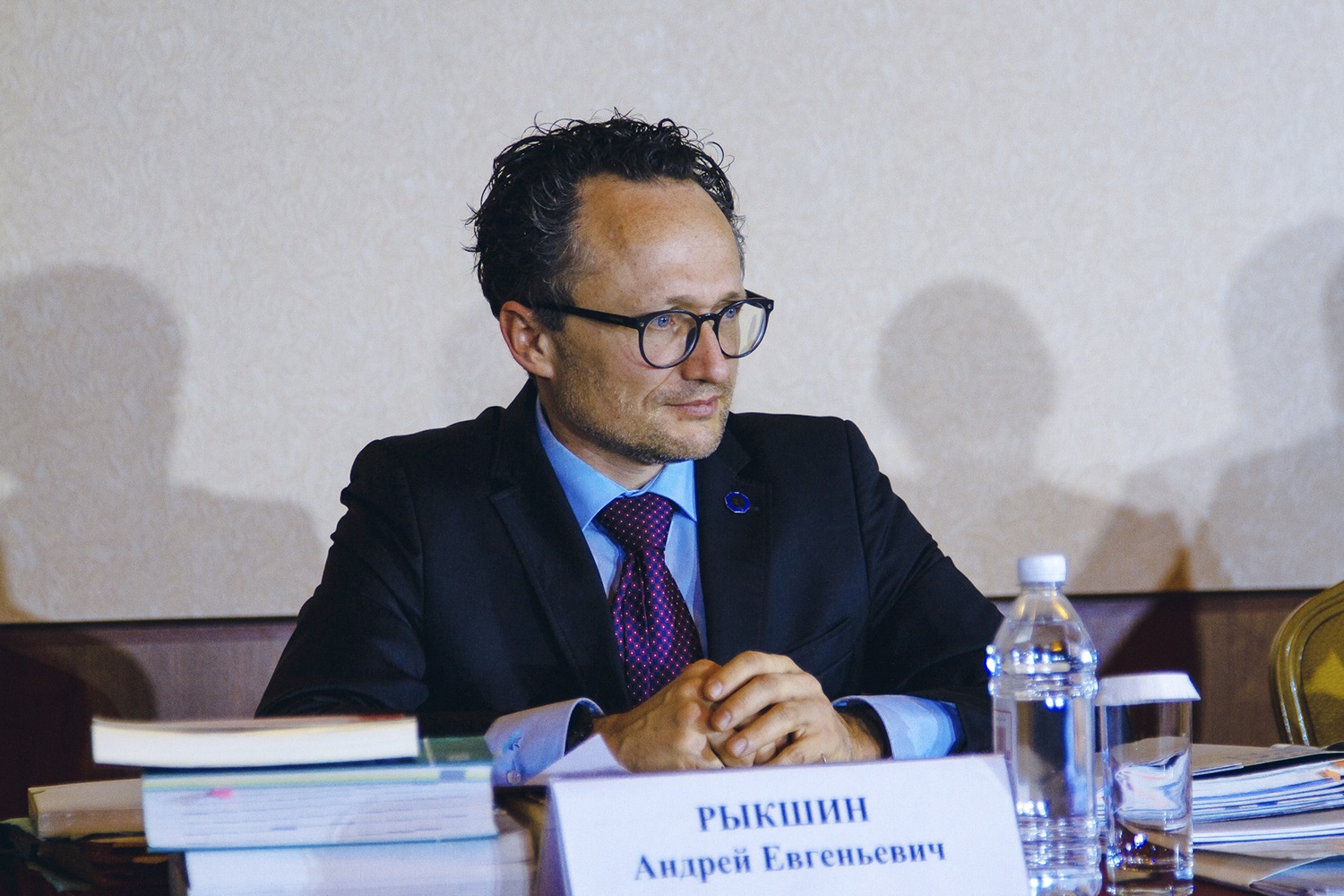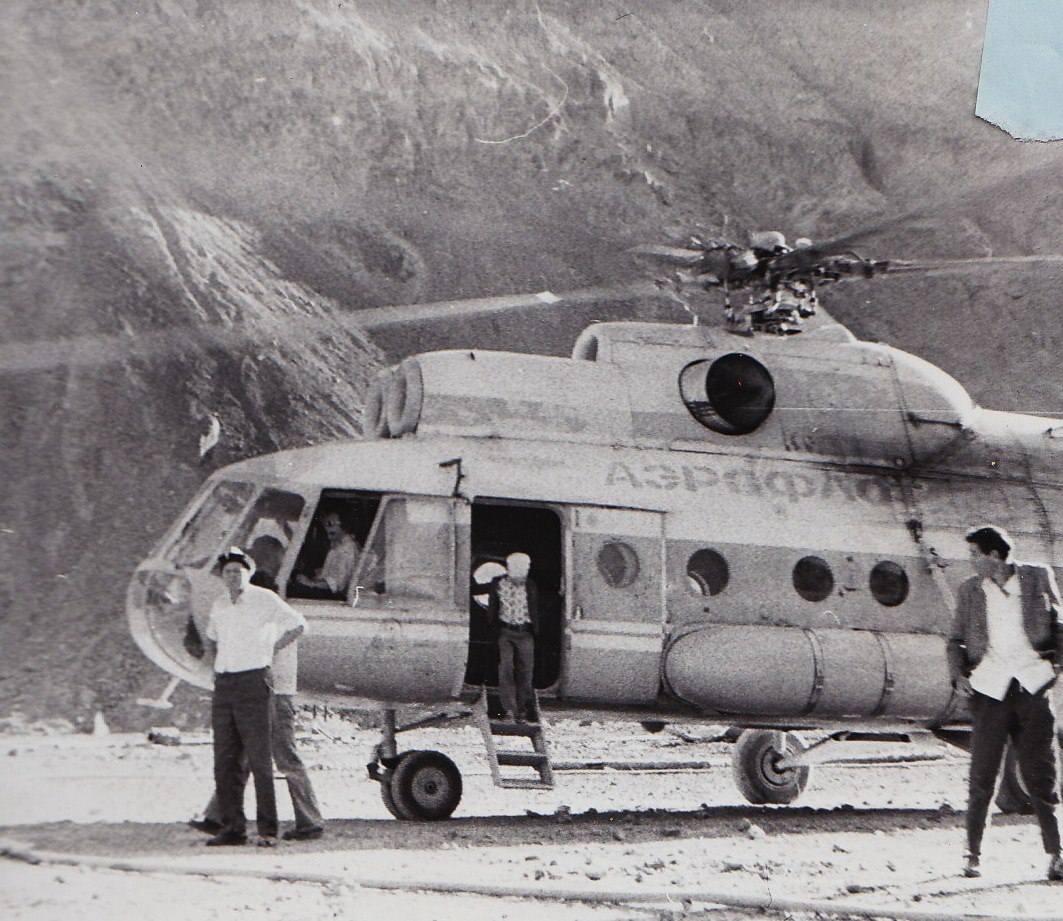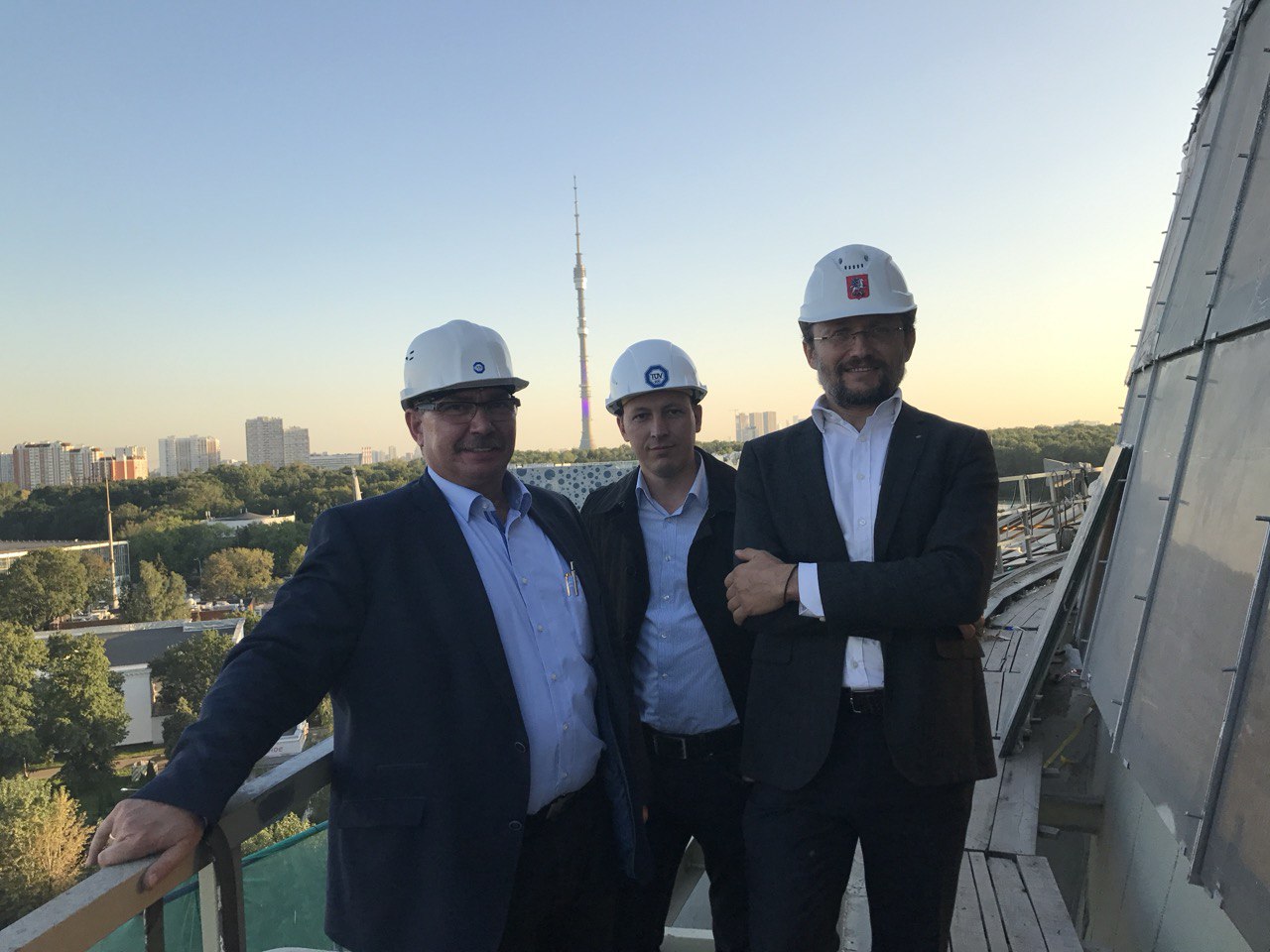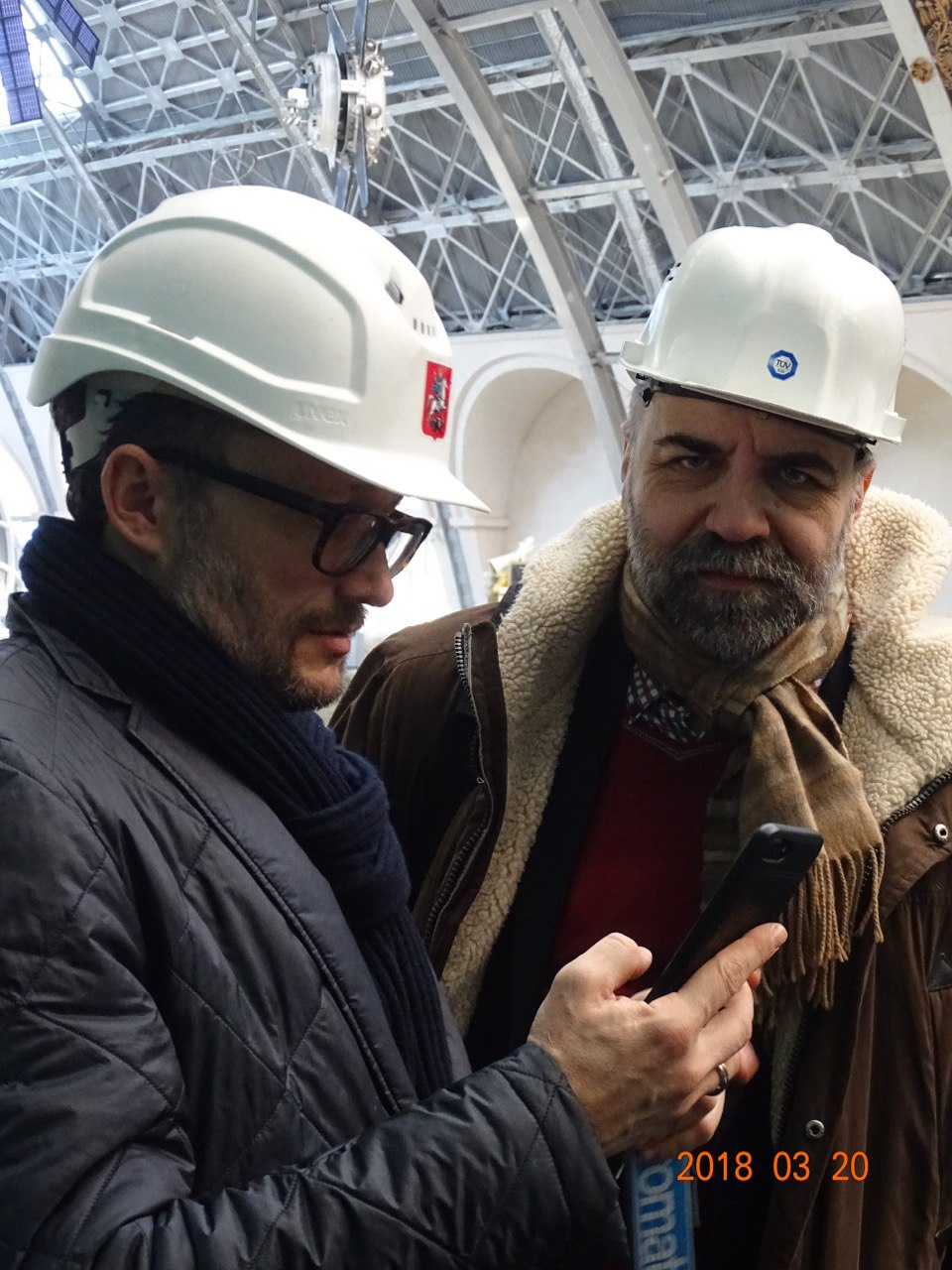A large-scale architectural transformation is taking place in the very heart of Dushanbe today. This process causes understandable public discussions and concern of Dushanbe residents for the preservation of historical sites. The latest such case was the recent decision of the city authorities to build a new business center on the site of the TV “Safina” building.
At the center of this discussion is the fate of the historical heritage site of “Shashmaqom” mosaic, which adorns the wall of the building.
What happened?
In 1976, muralist Asror Aminjanov created the famous "Shashmaqom" mosaic made of natural stone. This time is considered to be the heyday of mosaic art in Tajikistan. It was in the 60-80s of the last century that iconic works in the style of socialist realism, modernism and abstractionism appeared in Tajikistan.
The artist painstakingly collected natural stones for his mosaic in Tajik mountains, and then put his whole soul and his extraordinary talent into it. As a result, “Shashmaqom” mosaic has become a masterpiece in which every detail tells its own unique story. Years later, Aminjanov himself was called the "father of stone mosaics in Tajikistan."
In 2024, the Chairman of Dushanbe decided to preserve this historical mosaic for future generations. This task was entrusted to the TGEM company, which will erect a new building on the site of TV “Safina”.
TGEM is looking for experts
OJSC TGEM confirmed to “Asia-Plus” that they are well aware of the value of “Shashmaqom” mosaic and therefore took the task set by the mayor with all seriousness.
According to the representative of the company, when choosing experts, the main attention was paid to their experience in the preservation and restoration of historical sites.
As a result, the choice fell on an international team of experts led by engineer Andrey Rykshin. It is this team that will carry out work on the preservation and restoration of Dushanbe mosaic.
Who is Andrey Rykshin?
Rykshin is a restorer engineer with extensive experience in the field of construction and restoration of historical sites in Germany and Russia. Moreover, it turned out that Andrey hails from... Dushanbe!

“Asia-Plus” found the engineer's contacts in Germany, contacted and talked to him. It turned out that Andrey Rykshin is a representative of the engineering dynasty in the third generation. His grandfather, after graduating from the Kerch Polytechnic Institute, built the Kerch Metallurgical Plant and after that came to work in Tajikistan as an engineering technician, where he later became the head of one of the departments of the State Construction of the republic.
His grandmother worked as a chief accountant in the road building department. Andrey's father, Evgeny, was born here, who worked as a chief engineer at many construction sites in the republic in the system of the Ministry of Water Management "Tajikgiprovodhoz".
"I spent almost all my free time at my father's office during my school years. During the holidays, he took me on his work trips to various sites in Tajikistan and talked about his work. Then I visited the most remote corners of the republic with my father – Khujand, Garm, Kulyab, Penjikent. My helicopter trips with my father to remote areas of Pamir – to Rushan, Khorog, Sarez Lake, and Ishkashim - added romance to my perception of a civil engineer work.
All this was the reason for my choice of a future profession. People usually say that they don't choose their place of birth, but in my case, I didn't choose my profession either. I inherited it!", - says the expert.

In the early 90s, Andrey Rykshin entered Kuibyshev Moscow Institute of Civil Engineering (MGSU). Immediately after completing his studies in 1995, he began his career in construction companies in Moscow, worked his way up from foreman to deputy construction management.
In 1997, he was invited to work in Germany. Here, in Munich, he continued to engage in design, construction, and supervision in the field of construction.
In 2000, the young engineer became a co-founder partner of the design bureau in Munich, in 2004 he became a member of the Engineering and Construction Chamber of Bavaria, continuing his design and consulting practice in Germany and Russia. For the last 25 years, Rykshin has been actively involved in projects for the restoration of cultural sites in both countries.

"Finding a balance between the old and the new"
According to Andrey Rykshin, progress in urban planning is inevitable, it is a natural process - cities must change, become more modern, but at the same time it is necessary to maintain a balance between historical memory, which is important for self-awareness, and changes in the modern city.

"One of the main trends of modern architecture is the integration of innovative concepts into historical contexts," says Andrey. - Architects try to preserve the authenticity of old cities by introducing modern solutions and infrastructure that harmoniously fit into the existing landscape. This not only gives cities a unique look, but also creates comfortable living spaces."
Andrey Rykshin shares this approach and has repeatedly found successful solutions in his practice to modernize existing cultural facilities in a changing urban environment.
So, in 2001, as an engineer, he participated in the implementation of a project to ensure reliable protection of the medieval German cities of Würth am Main and Klingenberg am Main from frequent floods. The objective of the project was not only to make these settlements more protected from the threat of natural disasters, but also to preserve the coastal facades of historical buildings. A large design team found textbook engineering solutions, both for the forced loss of some fragments and for the preservation of the historical appearance of these cities.

"Due to constant floods, ancient cities have been devastated by natural disasters for many years. The German federal authorities have decided to restore the damaged facilities of these cities and ensure their reliable protection from future disasters.
We faced a difficult task: to determine which historical objects should be restored, fully preserving their original appearance, and which should be modernized, - Rykshin shares his memories. "As a result, our team managed to preserve the unique character of the cities and find modern solutions to protect them from floods."
New walls appeared on some streets to prevent buildings from collapsing under water pressure, while waterproofing systems were introduced on other streets, for example, windows in houses became waterproof, similar to those used in submarines, capable of withstanding water pressure.
Despite the major changes made to the structure of the cities, their historical spirit has remained unchanged, the expert notes.
"Tourists and locals today can enjoy the atmosphere of ancient buildings that have remained in their original form, despite the introduction of modern technologies to protect against natural disasters," he says.
Rykshin's Moscow projects
In Russia, engineer Rykshin and his team have implemented dozens of restoration projects. One of the examples of a successful combination of technical modernization and restoration of a historical object was the Chekhov Moscow Art Theater.
Under the leadership of Andrey Rykshin, a project was implemented here to introduce new technological equipment into this ancient building and transform the theater stage.
An important requirement of the project was the preservation of the historical interior of the theater, emphasizing its uniqueness and ancient character. The modernization work was carried out with maximum attention to detail, which allowed us to preserve the atmosphere of the past.
The technical modernization of the stage has significantly expanded the capabilities of actors and directors. Now the Moscow Art Theater stage is able to transform globally, creating the most modern productions. At the same time, the audience, being in the hall, does not notice the changes, since the carefully preserved historical interior of the theater visually remained the same.
The reconstruction project of the “Space” Pavilion at VDNH in Moscow has become another important project of our countryman and an example of successful restoration of historical heritage. During the pavilion restoration, fragments of an old mosaic made of gold smalt were found on the inner walls of the dome hall. This inspired a group of restorers led by engineer Rykshin to recreate this unique mosaic.
"Initially, we did not have such a task, but we accepted it, emphasizing the historical functional role of the pavilion as the pride of the country for achievements in mechanical engineering. It was important for us to preserve this imprint of time for future generations, people who are interested in the history of the past," says Andrey.

For this work in the “Space” pavilion, Rykshin and his team received the prestigious Moscow Government award "Moscow Restoration" in the best restoration and adaptation project category.
In addition, his team was awarded a special first-degree diploma of the organizing committee of the national independent architectural rating "Golden Capital". This work was also noted by the State Duma of the Russian Federation Federal Assembly in the form of gratitude for the contribution to the development of the concept and project of the “Cosmonautics and Aviation” Center on the territory of VDNH.

"Restoration is a concilium of doctors"
Andrey Rykshin compares the process of developing a restoration project with a consultation of doctors who decide on the fate of a patient – whether to remove an organ or try to save it.
Similarly, in the restoration of a cultural heritage site, each decision is analyzed, potential gains and losses are taken into account.
"The restoration of a cultural heritage site is a weighing of all the arguments for and against, where each step can lead to what we get or, conversely, lose," Rykshin notes. "This is a process in which it is important to maintain a balance between preserving historical heritage and implementing the necessary changes to ensure long-term sustainability."
According to the expert, for the self-awareness of the city and the nation, it is important to preserve as many artifacts as possible, which can be a memory, artistic or cultural value.
If the object is an art monument, then it is important to preserve it as the author intended, as carefully and efficiently as possible. This desire for balance and compromise becomes a key element in the restoration process, where each decision affects the preservation of cultural heritage and the perception of the city as a whole.

Andrey accepted the invitation to participate in the preservation of Dushanbe “Shashmaqom” mosaic because this project is not just an order for him. According to the engineer, this is a kind of return to the roots, to childhood, to the cultural heritage that has become an integral part of himself.
The expert sees each piece of the mosaic as a mystery, a part of Tajik history, in every detail of which lies the spirit of the past.
"There is an expression "architecture is frozen music", and in "Shashmaqom" mosaic it is embodied in the best way. I see a lot of metaphors here. This is not only the imprinting of an intangible heritage - shashmaqom music, which has been passed down from generation to generation for centuries without being recorded in sheet music. It is also the "music of stones", symbolizing the wealth of the mountainous country, - says Andrey Rykshin. – From the gifts of nature, a monumental recording was made in the form of a colorful "Shashamaqom" panel, and it was recorded not in notes, but in stone ...".
How will the process of preservation and restoration of the mosaic take place?
According to the expert, the work on “Shashmaqom” mosaic has already begun. Andrey recently came to Dushanbe to conduct an initial assessment of the canvas and discuss possible methods of preservation and modern use of the historical architectural work.
"We are developing a phased program for working with mosaics. There may be several forks in the conservation. In the near future, we plan to come again to begin a more detailed study for the execution of draft versions and the formation of draft drawings for the mosaic transfer," says Andrey Rykshin.
Today, there is enough engineering knowledge to efficiently transfer and preserve cultural heritage sites. It is impossible to ravage the business center investor, the company TGEM and the city administration with some unthinkable ideas. There must be a balanced decision, for it to be like this, a thorough on-site investigation is necessary."

In his opinion, structurally, the transfer of the mosaic is a difficult but achievable task. Restorers carry out thorough measurements, fully examine the structure, visually examine every crack, fix all the details.
Like the restoration of damaged paintings, where every thread is restored, the transfer of the mosaic requires the most careful attitude and attention to detail, especially to constructive auxiliary structures that will ensure its relocation to a new location.
According to Rykshin's deputy, Serbian architect Aleksandar Jovanovic, who will also work on the mosaic preservation, the invitation of foreign experts and the preservation of "Shashmaqom" represent a significant step forward for the Tajik capital, which has not previously engaged in such projects.
This process requires expert solutions and the involvement of all architectural and restoration forces of the city and an international team of specialists.

"An important part of this process is the training of local specialists. Inviting foreign experts who already have experience in such projects provides local restorers with the opportunity to learn and adapt best practices for future use. Such an exchange of experience creates a knowledge base and skills necessary for the successful implementation of such initiatives in the future," the Serbian architect notes.
According to experts, the Tajik mosaic is generally in good condition despite the fact that it has "lived" in sunny Dushanbe for almost 50 years. The wear of the panels was to some extent influenced by the water that used to flow down the surface of the mosaic. But a preliminary assessment shows that the existing damage is insignificant and quite amenable to subsequent restoration.
The beginning of a new stage in the development of Dushanbe?
The leadership of TGEM believes that “Shashmaqom” mosaic will soon find a new life and we are waiting for the continuation of the story that began with the artistic view of Asror Aminjanov back in 1976.
We can only add one thing: the initiative of the capital's authorities and the developer company to preserve the valuable mosaic may be the beginning of a new stage in the modern history of the Tajik capital, when the modern development of the city does not exclude the preservation of its cultural heritage.
We hope it may prove so.
THE AP DOSSIER:
Professional career of A. E. Rykshin and some of his projects for the restoration of cultural heritage sites (CHS):
1998 – 2000: Project manager in a German design organization:
Design and execution of a combination of solid basic protection and restoration of cities of the XIII-XVIII centuries from floods, Würth am Main, Klingenberg am Main;
2000 - present: Co-founder and partner of BUSL.ppm, Munich, Germany:
Restoration of the cultural heritage site "Prince Leopold Barracks Command Building";
Restoration with adaptation to accommodate the flagship Cabin of CUPRA electric vehicles in the historical center of Munich at Odeonsplatz 1;
The concept of restoration with the adaptation of an Officer's casino in the suburb of Berlin, Furstenwald;
2009 – 2011: Chief Project Engineer and Deputy Director General of the Institute of FSUE "SPETSPROEKTRESTOVRATSIA ":
Development and implementation of priority emergency and conservation measures to protect the cultural heritage site " Voskresensky New Jerusalem Monastery";
Development and implementation of priority emergency and conservation measures to protect the cultural heritage site "Ostankino Estate Museum";
Comprehensive restoration and preservation of the “Ryazan Kremlin” Cultural Heritage site and territory;
Project reconstruction of the cultural heritage site "Arbitration Court of the Volga-Vyatka district (City Duma building in Nizhny Novgorod)";
The concept of reconstruction with preservation of the historical appearance of the building of the Federal State Culture Institution "Polytechnic Museum");
2011 – 2014: Chief Engineer of the Institute of State Unitary Enterprise of the Moscow Research and Design Institute of Typology, Experimental Design:
The restoration project of the Architectural Monument "The building of the newspaper “Pravda” Combine";
Restoration of the cultural heritage site "Lutheran Church of St. Peter and Pavel in Moscow";
Restoration project of the cultural heritage site "Old Believers Theological and Teaching Institute", now school No. 459;
2014 – 2018: Head and partner of the Design and Restoration complex workshop Arhicad:
Reconstruction of Pavilion No. 57 (Light industry) for the adaptation of the Multimedia Historical Park "Russia - my Story", VDNH;
Restoration of the cultural heritage site "Space Pavilion" with adaptation for the Aviation and Cosmonautics Center, VDNH, (together with the MW Project);
2016 - present: Chief Engineer of the MW-Project Design Bureau:
Reconstruction of the cultural heritage site "Urban Estate – House of Bobrinskie";
Restoration and adaptation of the cultural heritage site "Theater on Malaya Bronnaya";
Restoration, reconstruction and recreation of the Northern Wing of the cultural heritage site "Tsurikov Manor";
Restoration of the cultural heritage site "Moscow Drama Theater named after M.N. Ermolova";
Restoration of the cultural heritage site "Church of the Nativity of the Blessed Virgin Mary on Kulishki";
Restoration of the cultural heritage site "Theater at the Nikitsky Gate";
The project of partial reconstruction of the cultural heritage site "Russian State Library (named after Lenin)".







